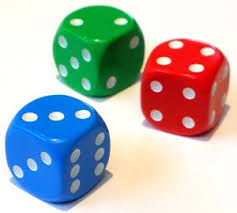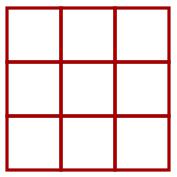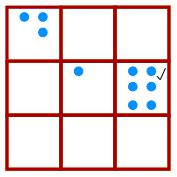Or search by topic
Number and algebra
Geometry and measure
Probability and statistics
Working mathematically
Advanced mathematics
For younger learners
Dotty Six for Two



- Game
Here's a game to play with an adult!

How do you play?
You'll need an adult to play with.
You'll also need a 1 to 6 dice (you could use our interactive dice), and a grid like the one below. You can print some off here.

Take turns with the adult to throw the dice and draw that number of dots in one of the boxes on the grid. Put all of your dots in one of the boxes. You can't split them up and you can't have more than six dots in a box. When a box is full, you could put a tick in the corner like this:

Keep going until there are three ticks in a row or column or diagonal. The winner is the person who puts the last tick.
Now, can you change the game to make your own version?
How do you know where to put your dots?
There is a poster of the game here.
The game as introduced is intended for KS1 children who are just beginning to become confident with small numbers. However there are many variations, some suggested below, that make it suitable for older children. Consolidation of basic number facts is combined with an element of strategic thinking.
Easier version: small children could use counters on a large grid. They could begin with six counters in each box and take away the number thrown on the dice.
Harder version: try using a different total, different dice, or a bigger grid. You could make the winner the first to complete a whole row that adds to a certain total (e.g. 20), change the shape of the grid (triangles rather than squares perhaps), or use a different sort of number - fractions, decimals, percentages...
There's a classroom version of this game here.
Related Collections
You may also like
Month Mania
Can you design a new shape for the twenty-eight squares and arrange the numbers in a logical way? What patterns do you notice?
Writing Digits
Lee was writing all the counting numbers from 1 to 20. She stopped for a rest after writing seventeen digits. What was the last number she wrote?

